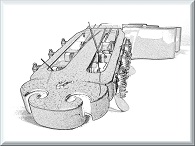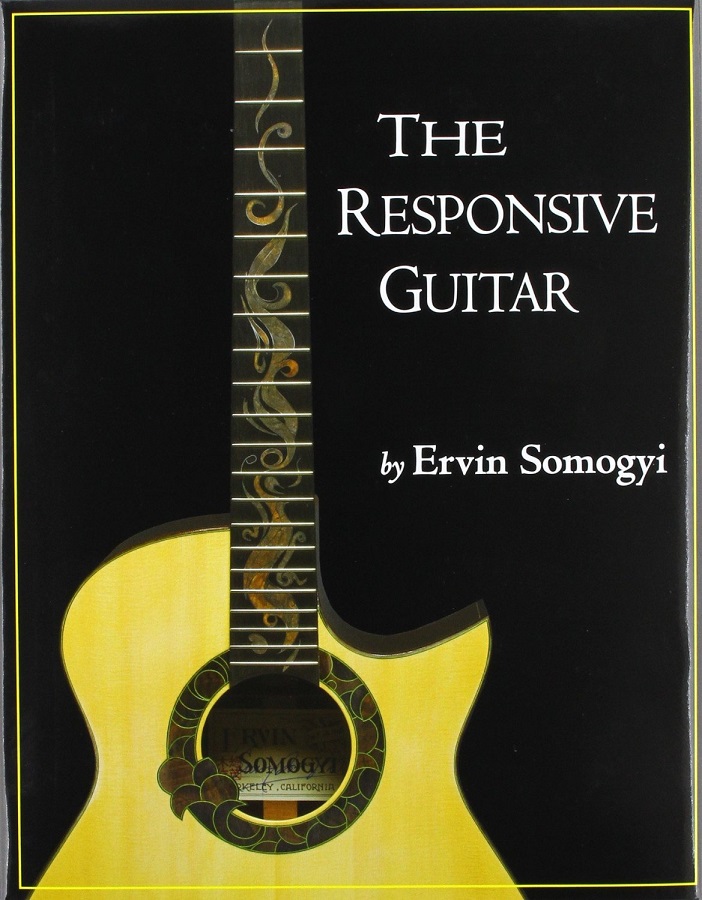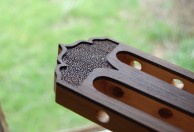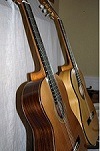Welcome to one of the most active flamenco sites on the Internet. Guests can read most posts but if you want to participate click here to register.
This site is dedicated to the memory of Paco de Lucía, Ron Mitchell, Guy Williams, Linda Elvira, Philip John Lee, Craig Eros, Ben Woods, David Serva and Tom Blackshear who went ahead of us.
We receive 12,200 visitors a month from 200 countries and 1.7 million page impressions a year. To advertise on this site please contact us.
|

|
|
Introducing luthier Ervin Somogyi
|
You are logged in as Guest
|
|
Users viewing this topic: none
|
|
Login  | |
|

  
Ruphus
Posts: 3782
Joined: Nov. 18 2010

|
 Introducing luthier Ervin Somogyi Introducing luthier Ervin Somogyi
|
|
|
Ever heard of Ervin Somogyi?
I hadn´t.
Here is an interview with him: http://blog.dreamguitars.com/an-interview-with-ervin-somogyi-part-1/
Rationally explained detail on conditions related to guitar making, much of which one might have never heard of.
With the man himself saying that it is not necessary to be aware of all such, only that it can help to know about it.
And with one point he finally delivers the understandable support for what Tom Blackshear has been trying to communicate more or less successfully, whilst backing his message rather practically with remarkably voiced instruments.
Somogyi sumrizes that one pretty clearly with:
quote:
The Cube Rule (it’s my wording; engineers call it different things) is a fundamental principle of physics and engineering. It states that the load-bearing capacity of a material such as a beam or joist is a cubed function of its height or thickness. That is, a ceiling rafter one inch thick has a ‘stiffness’ of one (1 x 1 x 1); a floor joist that is two inches thick is eight times as stiff (2 x 2 x 2); a beam that is three inches thick is twenty-seven times as stiff as the first one (3 x 3 x 3); and so on. What this geometric progression means is that relatively small increments of thickness can translate to significant differences in stiffness.
The percentages/gross numbers are the same for every unit of measurement: that is, the same formulas and numbers work for inches, feet, centimeters, etc. And they work the same on the small scale of guitar parts, too. What this means is that a thirty-second of an inch or two, or even less, maybe just a few thousandths of an inch too much or too little, one way or the other, can make a difference of stiffening or loosening a guitar top by as much as 100%. You can really hear that; it’s certainly worth knowing about. Especially when you can appreciate that you’ve unknowingly been making one guitar top up to two or three times as stiff as your last one, without knowing you’ve done so. From the standpoint of the strings, that’s hugely significant. Your guitars will of course sound very different from one to another, possibly without your having any clue as to how you’ve managed to do that. And it’s all from adding or taking away very small amounts of wood.
An important corollary to the above is the connectedness of your structure. If your braces are a little longer or shorter (even if they’re the same size), or are a little further from or closer to their neighboring braces, or possibly angled a bit differently, it makes just as much difference.
I found his interview amazingly informative, and as hypothetical luthier could be getting me his book, independently of eventually making perfecly fine instruments already.
Even just in the way a Sebastian Vettel could be reading Enzo Ferrari´s biography.
Ruphus
|
|
|
|
REPORT THIS POST AS INAPPROPRIATE |
Date Jul. 22 2013 15:37:51
 |
|

   
krichards
Posts: 597
Joined: Jan. 14 2007
From: York, England

|
 RE: Introducing luthier Ervin Somogyi (in reply to Guest) RE: Introducing luthier Ervin Somogyi (in reply to Guest)
|
|
|
quote:
The Cube Rule thing made me laugh.
A good engineer and a good luthier should get together, study this matter, and build a set of guitars. Or maybe a good luthier that is also a good engineer (best combo although hard to find). I say this because not knowing the science behind it can cause people to talk crap or veer off in irrelevant directions.
The topic introduced is relevant to the way a guitar sounds, but there is so much more to material stiffness than that (especially wood).
Material stiffness depends on the elements and compounds from which it is made, and, most importantly the molecular structure of the material.
The stiffness of an individual piece of stuff depends on the material from which it is made and its dimensions.
The cube rule refers to the dimensions of an individual piece, assumed to be homogenous. Its not funny! Its real, and most luthiers would be aware of it, if not formally, then maybe via experience.
_____________________________
Kevin Richards
http://www.facebook.com/#!/kevin.richards.1048554
|
|
|
|
REPORT THIS POST AS INAPPROPRIATE |
Date Aug. 8 2013 11:28:16
 |
|

   
estebanana
Posts: 9355
Joined: Oct. 16 2009

|
 RE: Introducing luthier Ervin Somogyi (in reply to Ruphus) RE: Introducing luthier Ervin Somogyi (in reply to Ruphus)
|
|
|
The idea behind examining wood and evaluating it with engineering terms is not because you can purely engineer a guitar to function; There are too many variables in wood, the process of building and the all the variables inherent in designs. It's simply too complex an assembly to completely engineer it or calculate how it functions. The most cutting edge people who are building guitars now with technological tools to keep track of data will tell you this straight up.
The engineering comes in as a process to record some base statistics, the data that will get you in the ballpark. For example the concept of figuring mass, strength and weight gives some guidelines about which tops are in the mass to stiffness profile which has made good instruments. After that thinning a top is still a process of *intuition informed by experience*. ( I actually said this to Somogyi once and he responded by saying "Well said." )We all can use the math-engineering data to select tops which have proven to have potential based on the mass which the energy from a string can activate. A nylon string puts out very little energy in relation to how much mass it has to activate, the trick is this:
How much wood do you leave in the guitar to give it a lower mass so the string can activate it, yet retain strength so the top does not become inefficient do to lack of strength? And to complicate it, how do you articulate the braces in order to maximize lower mass and strength? Then you marvel over a design in a guitar by Daniel Friedrich or Fleta and you say to yourself "How can this work with all that timber in there?" You have to puzzle over this paradox that things are constantly thrown back at you once you understand one way of conceptualizing the design.
That, as Shakespeare wrote, is (are) the question(s). Engineering alone cannot solve the problem because the variables in guitar making are almost infinite. Engineering can direct the guitar maker to materials and process choices which narrow the chances of selecting incorrect materials or assist in for instance, thinning the top. The final choices in thinning a top or selecting materials are a matter of personal opinion, the opinion can be informed by engineering, but the last plane stroke or chisel pass is not left to math, it's left to a persons intuition. Why? Because the engineering process makes available a myriad of personal choices and in the end the guitar maker has to make selections about what he or she wants. There is no such thing as an ultimate guitar because the guitar itself is imperfect. There will always be small choices to make no matter how much engineering is used do to the fact that a guitar is a series of trade offs. One must learn about yourself as a builder by the choices you make a the intent of your direction.
In the end it's mostly luck, having an unhealthy obsession with flexing and tapping spruce, and going out armed with a few engineering concepts which get you in the ballpark. You can also read every book and still do it your own way. The books just give you working concepts to think about, they don't prove anything, they are simply one persons opinion about what works. In the end you actually have to put plane to wood to get it.
_____________________________
https://www.stephenfaulkguitars.com
|
|
|
|
REPORT THIS POST AS INAPPROPRIATE |
Date Aug. 9 2013 6:10:27
 |
|

   
krichards
Posts: 597
Joined: Jan. 14 2007
From: York, England

|
 RE: Introducing luthier Ervin Somogyi (in reply to guitarbuddha) RE: Introducing luthier Ervin Somogyi (in reply to guitarbuddha)
|
|
|
quote:
What exactly is meant here by 'molecular structure' as it relates to wood.
Is the molecular structure of wood homogeneous ? No.
Is wood composed of one discrete molecule ? No.
Is the warp and weft of cellulose strands homogenous in any wood ? No.
Is the moisture content of wood fixed ? No.
Is the disrtibution of moisture homogeneous in wood ? No.
Perhaps I should simply have said 'structure'?
I agree that wood is not homogenous, its a complex composite of polymer molecules, resins, water, fibres etc
But I use the cube rule as a rule of thumb. It reminds me of an important principle regarding stiffness, eg you'll increase the stiffness of a brace much more by making it thicker rather than wider.
Many luthiers will not acknowledge their own (intuitive) use of engineering and scientific principles but they use them nevertheless. That's ok; we are all different.
The interesting thing about the flamenco guitar is that the design is pretty much fixed. A small range of thicknesses, a few variations in the number and patterns of the bracing, small variations in body size and depth etc.
The really important factor is stiffness and how it varies across the soundboard. Some luthiers deal with this intuitively, and others prefer to use more science.
But for all of us, there is no substitute for experience, trial and error/improvement. That's what makes it endlessly fascinating.
Incidentally, why isn't this thread in the luthiery section?
_____________________________
Kevin Richards
http://www.facebook.com/#!/kevin.richards.1048554
|
|
|
|
REPORT THIS POST AS INAPPROPRIATE |
Date Aug. 9 2013 11:47:08
 |
|

   
estebanana
Posts: 9355
Joined: Oct. 16 2009

|
 RE: Introducing luthier Ervin Somogyi (in reply to Ruphus) RE: Introducing luthier Ervin Somogyi (in reply to Ruphus)
|
|
|
Shroomy, let me ask, what parts of guitar making interest you from an engineering standpoint?
Are you familiar withe the work Daniel Friedrich the French guitarmaker did in the 1960's and 70's with acoustic engineers? He did some very basic stress testing that has become a methodology for many current guitar makers.
Funny story about Ervin Somogyi; I first wanted to study with him and I kept bugging him with phone calls and dropping to his shop. He wanted $80.00 bucks an hour for guitar making lessons and consultations. I saved enough money for a few lessons and kept asking to set date for a lesson. He kept putting it off and I became more and more frustrated.
I was standing at the bar in the the Albatross Pub in Berkeley CA one night about that time I was pestering Somogyi. Keni Parker was playing his usual Thursday night flamenco gig and the Albatross became a meeting place for flamencos, both professionals from Spain on tour and locals. When there was a singer passing though town someone inevitably brought them over to the Albatross and Keni would accompany them until early in the morning with core group of six of eight people staying after hours. One of the faces you could see weekly at the Albatross was Eugene Clark the famed and mysterious flamenco guitar maker. I was standing next to him and asked if he wanted a beer. He said no I'm not drinking. I asked him if he wanted a coke then and he accepted. We chatted and listened and soon off he went.
Next week he was there again, same spot next to me. I said "Wanna Coke?" He said sure. He asked me what my interest in flamenco was, then said "Are you chasing skirts or something?" "Well I play, but I'm interested guitar making." He recoiled. I shut up. After about an hour we met up again at the bar, he said "So you're interested in guitar making huh?" I took the opportunity to tell him I had worked in a few violin shops and that I wanted to build guitars. He said he got his start from a violin maker too and it gave us some mutual ground. After he found out I had some experience he asked how I would go about guitar making. I said I don't know, but if I could look at your tools it would tell me how to begin. He asked why I believed that. I said if I can see your tools I will be able to read how you use them and that will enable me to start. He liked that answer very much and temperamentally it was apparent to me at that moment Gene was my teacher not Ervin.
Coincidentally, because Somogyi is a smart man and generous with comrades who build guitars he had just commissioned Eugene to build him a flamenco guitar. So my first days visiting Gene were spent watching him actually build Somogyi a blanca. Eugene will probably never write a book about guitar making because does not teach that way. Any of the Eugene students will tell you however that he transmits information. It may not be laid out in a format where you can connect the dots as if point A leads to point to B.....something that Somogyi fully recognizes in his practice as well. Many of the great makers who have taught have not been articulate in a literal way and some have. But here's the deal I keep trying to convey, it does not matter whether you read a dozen books; the books are conceptual guideposts, they can steer you a certain direction keep you out of certain minefields, but you still have to make choices for yourself.
Another teacher may push you to solve problems the way Gene does, it's the opposite of being fed information, he takes information away and asks you to back yourself though the process to figure it out. It's simply another way of transmitting the teaching. It's important to recognize this because we as human beings do not all learn the same way. A book that might help one person may not add anything to another persons conceptual framework. And the teacher who shows by doing might not be right for the student who wants a book.
Books are neither right nor wrong, they are simply another avenue to check out. The time vetted method was for guitar making to be transmitted one on one from teacher to student. That is still the most effective way to learn. But a book can come in handy as another guide on the path.
So for the cost of several of Somogyi's lessons at $80.00 bucks per hour you can just buy the book, but you still don't get the man in person which would be much more valuable. If you were to watch him work you would perceive things that are not in the book.
_____________________________
https://www.stephenfaulkguitars.com
|
|
|
|
REPORT THIS POST AS INAPPROPRIATE |
Date Aug. 10 2013 12:58:05
 |
|

   
estebanana
Posts: 9355
Joined: Oct. 16 2009

|
 RE: Introducing luthier Ervin Somogyi (in reply to Ruphus) RE: Introducing luthier Ervin Somogyi (in reply to Ruphus)
|
|
|
Shroomy,
I'm gonna duck out of this convo, but allow me to say one more thing.
There are are some books out today that cover engineering in luthiery, as it applies, and you might want to check them out. There is also a Yahoo Group called Left Brain Luthery, if they are still going I bet they would love to have a another real engineer in the group. If you google search Left Brain Luthery you will find David Hurd's book by the same name. David Hurd is an engineer who makes instruments and the book deals with engineering in as far as it can be used in guitar making.
In the Bay Area a lot of credit should go to John Gilbert the retired guitar maker as he did a lot of work in the area of stress testing and measuring deflection of materials. If you asked Somogyi I wager he would say that if not a portion of the actual material in his book, some of the models for figuring things out came from John Gilbert and other guitar makers.
Another luthier who has done a lot of sonic research with tone generation as it applies to guitar is Alan Carruth, I highly recommend you read his essay available online called 'String Theory'. He does in depth work with string engineering and stress tests on common sets of guitar strings. Particularly his observations about the behavior of high partials is interesting.
Over the last 40 years the GAL publication, Guild of American Luthiers has published articles about guitar making and engineering. If you know luthier who has old copies you could borrow I think you would enjoy them.
There are several builders today writing on subjects which involve engineering to some extent. Think of makers like Dammann who has created essentially anther style of top for the guitar, ask yourself: Was it by trial an error or was it be pre engineering and trying it out? More important than pure engineering is how he integrated it into the building process. Kevin Richards said it best a few posts ago, I reiterate the theme. The flamenco guitar is pretty set in it's format, you have to go to the masters for your examples, you'll build a profound and satisfying guitar if you study them as a base to begin from. Does it really need to be engineered further? That depends on how you use engineering, but by trial and error the masters arrived at a complete system based on and kind of vernacular engineering called guitar making.   
I hope the references to the books & articles prove interesting. Later
_____________________________
https://www.stephenfaulkguitars.com
|
|
|
|
REPORT THIS POST AS INAPPROPRIATE |
Date Aug. 11 2013 0:26:36
 |
|

   
estebanana
Posts: 9355
Joined: Oct. 16 2009

|
 RE: Introducing luthier Ervin Somogyi (in reply to Ruphus) RE: Introducing luthier Ervin Somogyi (in reply to Ruphus)
|
|
|
I've been thinking the last few days about the great master Manuel Velasquez(since he's been mentioned here, misquoted and judged unfairly..) a few years ago, 2010 if I remember right, the annual Guild of American Luthiers selected Velasquez as the guest of the honor at the big summer meeting in Tacoma Washington. I was not able to attend, but I called Eugene Clark after the week of meetings to ask him how his presentation went. He did not want to talk too much about it, so we chatted about other things on his mind.
Gene really wanted to tell me about Manuel Velasquez coming to visit him one afternoon at Gene's home. Understand that Velasquez was 92 years old and Gene into his later seventies as they stood before Gene's workbench with a guitar in process. He said Manuel held his hand and cried while telling Gene he was so happy Gene was carrying on the tradition passed from teacher to student, and that he was making the guitar as the masters older than Gene and Manuel had done for generations.
I remember calling Velasquez on the phone in 1989 when I lived in Washington D.C. I wanted to learn guitar making, but I did not have the confidence. Sr. Velasquez said he would receive me for a visit, but I never went to see him because I thought he wanted to show me a guitar with the intention of selling me a guitar and I felt like I was not in a position to ask him to teach me about guitar making. It was hard for me to ask him to teach me guitar making because he was a great master and I was a dumb kid. I kick myself now for not following through and going to trouble the maestro.
You never know how things will turn out, Sr. Velasquez might have been really gracious or he might have deemed me another wise guy who wanted to make guitars. The reality is that he probably had a lot of things on his mind and one more kid knocking on the door asking to be taught might have been too much to take on. Good thing I met Eugene nine years later and told him this story.
I hope in the next year or so I get a chance to go visit Gene so I can put my arm around his shoulder and look at his work bench. In the end its not about books, really, it's about your teacher and how you keep working with what they transmitted to you.
And perhaps it's an insignificant detail, but there is a world of knowledge in those thumbs. Was it really Manuel Velasquez who said my thumbs know everything that I could pass could on? Or was it everyone? Torres to Santos to Manuel Reyes...
Probably was, you gotta keep your Manuel's straight.
_____________________________
https://www.stephenfaulkguitars.com
|
|
|
|
REPORT THIS POST AS INAPPROPRIATE |
Date Aug. 14 2013 8:09:29
 |
|
 New Messages New Messages |
 No New Messages No New Messages |
 Hot Topic w/ New Messages Hot Topic w/ New Messages |
 Hot Topic w/o New Messages Hot Topic w/o New Messages |
 Locked w/ New Messages Locked w/ New Messages |
 Locked w/o New Messages Locked w/o New Messages |
|
 Post New Thread
Post New Thread
 Reply to Message
Reply to Message
 Post New Poll
Post New Poll
 Submit Vote
Submit Vote
 Delete My Own Post
Delete My Own Post
 Delete My Own Thread
Delete My Own Thread
 Rate Posts
Rate Posts
|
|
|
Forum Software powered by ASP Playground Advanced Edition 2.0.5
Copyright © 2000 - 2003 ASPPlayground.NET |
0.109375 secs.
|


 Printable Version
Printable Version














 New Messages
New Messages No New Messages
No New Messages Hot Topic w/ New Messages
Hot Topic w/ New Messages Hot Topic w/o New Messages
Hot Topic w/o New Messages Locked w/ New Messages
Locked w/ New Messages Locked w/o New Messages
Locked w/o New Messages Post New Thread
Post New Thread